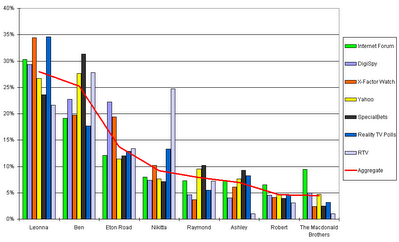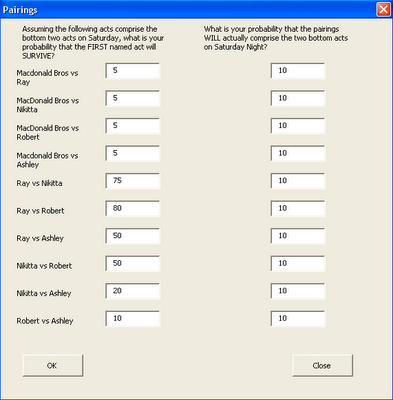Elimination Speculation - Calculating Fair Odds;
Earlier in the week, we took a look at how the polls have been performing with regards to helping us predict which act will leave the X Factor each week. The only sensible conclusions we could reach were:
Category 1
Acts that have up to 10.6% core support in the polls and sing badly on the night can find themselves in the bottom 2.
Category 2
Acts whose core support is ranked at 7th or below (or lets say "bottom quartile" as the numbers dwindle) can find themselves in the bottom 2 even if they sing well on the night
Bearing these facts in mind, let's take a look at the current polling landscape:


Looking at the poll of polls, we find The MacDonald Brothers toward the bottom of the table again, albeit with a slightly better showing at The Internet Forum and DigiSpy.
We also see Robert fitting perfectly into a "category 2" act, and given that he has already been beaten by The Macdonald Brothers in a previous show, he is looking vunerable again this evening.
How can we account for the remainder of the acts? In previous weeks acts above 5.6% in the polls tend to need to have a bad song to make it into the bottom two, but that was with a lot more sub 5.6% acts in the competition.
The bottom line is that we can't be sure that Nikitta, Ray, and Ashley are safe. We can make the assumption that Ben, Leona and Eton Road are safe however, without stretching the bounds of reason.
This leaves us with five acts, and hence ten possible bottom two pairings. Let's assume that each of these pairings is equally likely to be the bottom two (i.e. 10% chance). We can then say, assuming that each pairing turns out to be the bottom two, who is likely to survive? This is where we can factor in information such as The Macdonald Brothers almost certainly being beaten by all four of the other acts should they make the bottom two. Other pairings are harder to call, and hence are 50/50, but here is a screenshot from a model we have been developing that can help us to quantify our views. The opinions represented in the left-hand column are Statman's own .

As you can see, I have allocated a 5% probability that the MacDonald Brothers will survive against any other act should they wind up in the bottom two this evening. Other pairings can also be seen, and you can see for example that in the scenario Nikitta vs Ashley, I have allocated a 20% probability that Nikkita would survive. The right hand column shows that I have allocated an equal probability of 10% that each pairing does actually turn out to be the bottom two.
Using these assumptions, the model tells us the following:

The result above is only important to me because I believe my input probabilities are sensible, and as such I can use these results to find value in the betting exchanges according to my assumptions.
If you don't believe my probabilities are reasonable, then please feel free to suggest alternatives, because I understand that each gambler will have different subjective inputs.
The model was devised to be a tool to help readers find value, rather than display a set of odds that I personally think is superior, so please feel free to send your probabilities to me.
Best
Statman
Category 1
Acts that have up to 10.6% core support in the polls and sing badly on the night can find themselves in the bottom 2.
Category 2
Acts whose core support is ranked at 7th or below (or lets say "bottom quartile" as the numbers dwindle) can find themselves in the bottom 2 even if they sing well on the night
Bearing these facts in mind, let's take a look at the current polling landscape:


Looking at the poll of polls, we find The MacDonald Brothers toward the bottom of the table again, albeit with a slightly better showing at The Internet Forum and DigiSpy.
We also see Robert fitting perfectly into a "category 2" act, and given that he has already been beaten by The Macdonald Brothers in a previous show, he is looking vunerable again this evening.
How can we account for the remainder of the acts? In previous weeks acts above 5.6% in the polls tend to need to have a bad song to make it into the bottom two, but that was with a lot more sub 5.6% acts in the competition.
The bottom line is that we can't be sure that Nikitta, Ray, and Ashley are safe. We can make the assumption that Ben, Leona and Eton Road are safe however, without stretching the bounds of reason.
This leaves us with five acts, and hence ten possible bottom two pairings. Let's assume that each of these pairings is equally likely to be the bottom two (i.e. 10% chance). We can then say, assuming that each pairing turns out to be the bottom two, who is likely to survive? This is where we can factor in information such as The Macdonald Brothers almost certainly being beaten by all four of the other acts should they make the bottom two. Other pairings are harder to call, and hence are 50/50, but here is a screenshot from a model we have been developing that can help us to quantify our views. The opinions represented in the left-hand column are Statman's own .

As you can see, I have allocated a 5% probability that the MacDonald Brothers will survive against any other act should they wind up in the bottom two this evening. Other pairings can also be seen, and you can see for example that in the scenario Nikitta vs Ashley, I have allocated a 20% probability that Nikkita would survive. The right hand column shows that I have allocated an equal probability of 10% that each pairing does actually turn out to be the bottom two.
Using these assumptions, the model tells us the following:

The result above is only important to me because I believe my input probabilities are sensible, and as such I can use these results to find value in the betting exchanges according to my assumptions.
If you don't believe my probabilities are reasonable, then please feel free to suggest alternatives, because I understand that each gambler will have different subjective inputs.
The model was devised to be a tool to help readers find value, rather than display a set of odds that I personally think is superior, so please feel free to send your probabilities to me.
Best
Statman

6 Comments:
The latter half of your thinking in the above post doesn't work (and didn't work last night) because you are working out probabilities based on the wrong data. The decision is made by the judges, not the audience, and therefore popularity counts for very little. In fact the decision is being made by ONE judge, the judge who doesn't have an act in the bottom two (rarely two judges might have the deciding vote) - I conclude this as the judges back their own acts 99% of the time (only case I can recall when this wasn't so was Simon not backing that arguementative Irish sisters group last year). And if you can find a formula to work out how the judges fickle minds work then you'll no longer be working out betting odds for a living!!! :D
Thanks for your comments Claire.
I would suggest that the autonomy of the judges that you refer to is indeed captured by the model, the left hand column reflecting exactly that.
For each pairing, it reflects your take on what the deciding judge(s) would choose to do given that pairing makes the bottom two.
What was missing in my personal odds this week became apparent to me as soon as Simon appeared at the start of the show and held four fingers aloft. It was at that point that I realised his acts were going to be targeted by Sharon and Louis should one of them make the bottom two that evening. Consequently this palyed out with Louis' decision to send Ashley home.
Therefore, instead of allocating a 10% chance of Robert surviving against Ashley, this "stop Simon" factor in reality meant the odds were much higher.
As I said in the post, it is not my inputs that are important, it's the inputs of the user, and on that basis I have to disagree that the model "doesn't work".
I think you overrated Ashley's popularity with the judges in the first place... if he was going to be bottom 2, this week, which he WAS, it would mean he'd more than likely put in 2 poor performances in 2 consecutive weeks - whoever he was up against, he was likely to be out of favour with whichever judge (Sharon or Louis) had the casting vote.
Obviously, your figures could never have been wholly accurate, but I think Ashley had been on a slippery slope and your odds for him were wildly high at 11-1.
Other than that, I think your model makes very interesting reading.
Thanks Nick, and good point.
Exactly the sort of discussion I'm trying to evoke - preferably before the event next week! ;)
That's OK mr Statman. I find your work absolutely fascinating and am intrigued to know how well you manage to predict things!!
I was as gutted as you when you got the BB winner wrong - not because I necessarily wanted Aisleyne to win (though I did), but because it meant science had been flawed. :(
As Thomas Edison once said:
"I may have got something wrong 10,000 times, but I have never failed".
Science has only ever been proved to be flawed temporarily. It thrives on finding weaknesses in it's process, because that's how it evolves, and that's how our understanding gets better.
Post a Comment
<< Home